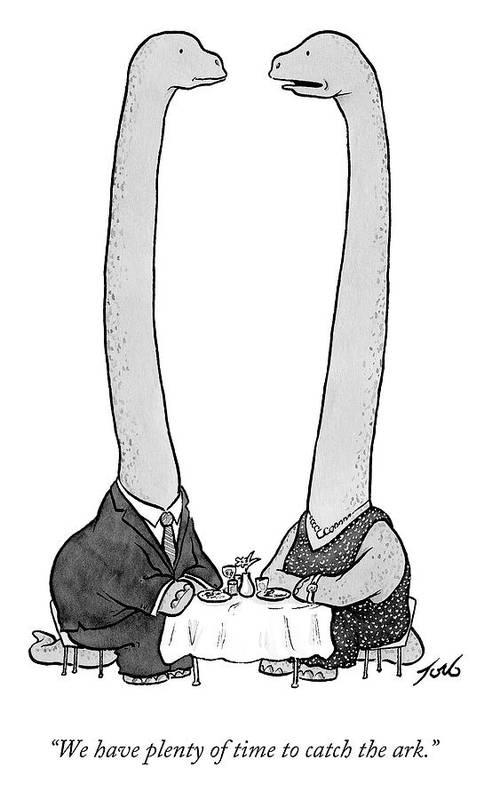
A cartoon by Tom Toro, published in the October 23, 2023 New Yorker magazine (https://condenaststore.com/featured/plenty-of-time-to-catch-the-ark-tom-toro.html?product=art-print)
Dinosaurs in Judaism "on one foot":
While dinosaur bones were discovered in early China (where they were attributed to dragons), and a few were found in England in the 1600s, dinosaur research didn't really take off until the 1800s (CE). Therefore, Jewish texts prior to this were silent on the matter of dinosaurs, and Jewish texts since then haven't had much to say either. Nonetheless, in the Venn Diagram of "Dinosaurs" and "Judaism", there are a few things in the overlapping section.
Do I Hear Someone Knocking?
"There's a Dinosaur Knocking at My Door"
By: Andi Joseph (used with permission)
There’s a dinosaur, knocking at my door,
Knocking 1, 2, 3 (echad shtayim shalosh!)
There’s a dinosaur, knocking at my door,
And he wants to spend Shabbat with me.
First we'll light the candles
And then we'll bless the wine
Then we'll bless the challah,
And have a real good time.
There’s a dinosaur…Shabbat with me.
Context: This is a Jewish version of a 1989 song originally by Linda Arnold (preceding Barney the Purple Dinosaur in 1992). Andi Joseph and Mimi Greisman recorded the Jewish version in 1996 on the "I've Got a Shabbat Feeling" album - https://www.musicalmommy.com/#cds (kippa tip to Maxine Handelman). The original lyrics were "Then we'll bless the challah / And we'll all eat dinner together" - https://www.facebook.com/JKidsRadio/videos/594838312765715/ - but they have been folklorized to rhyme. According to a personal conversation with Andi, she was introduced to somebody who had made a Jewish version of the original song, and with permission she adapted the song and added it to the first album that she was recording since so many people were interested in what she had done.
The Song Inspires Some Books

Diane Levine Rauchwerger is a synagogue children's librarian who changed the words to the Dinosaur song for each holiday (https://jewishlibraries.org/wp-content/uploads/2021/03/RauchwergerText2015.pdf). Eventually these turned into a series about the dinosaur that's visiting for Shabbat, followed by the dinosaur that comes for Hanukkah, for Passover, and for a trip to Israel (see more here: https://lernerbooks.com/shop/show/12010). Rauchwerger has not only been the children's librarian at Congregation Beth Am in Los Altos Hills, CA, but she was a children's librarian at a public library and served as the chair of the Sydney Taylor Award for the Association of Jewish Libraries.
This is the book being read on YouTube.
Age of Dinosaurs vs. 57_ _
Scientists date dinosaurs to millions of years ago, whereas in the Jewish year it has only been 5,700ish years since the creation of the world. There are a number of ways of reconciling these two dates:
1. According to the Chabad Rebbe, Menachem Mendel Schneerson (1902-1994), G-d created fossils and put them in the ground (https://www.chabad.org/library/article_cdo/aid/112083/jewish/Theories-of-Evolution.htm - kippah tip to Miron Hirsch)
2. When wooly mammoth fossils were discovered, Rabbi Yisrael Lipshitz (1782-1860, author of the “Tiferes Yisrael” commentary on the Mishnah) quoted the Talmud (Chagiga 13b:14) as saying that there were 974 generations before Adam, and so the fossils come from a previous generation before humanity (https://aish.com/dinosaurs/)
3. Rabbi Yisrael Lipshitz also quoted Kabbalists who said that there were multiple epochs/worlds created before now (based on Rabbi Abahu - B’reishit Rabba 3:7), so fossils come from a previous iteration of the world (https://ohr.edu/ask_db/ask_main.php/238/Q1/)
4. The Malbim (Rabbi Meir Leibush ben Yehiel Michel Wisser, 1809-1879) lived in the 19th century when fossils were being discovered. In his commentary on Genesis 7:23, he claims that these were from giant animals swallowed by earthquakes after they survived the Flood (https://judaism.stackexchange.com/questions/20705/what-is-the-torah-view-on-the-dinosaurs - lots of other ideas here).
5. Time was measured differently before the Flood. Thus, one “day” of Creation might have been millions of years. The order of Creation generally aligns with the order of the scientific accounting for how the world came to be; it’s just a matter of time scale. Dinosaurs were created at the beginning of Day 6, and were gone before humans were created at the end of Day 6 just before Shabbat (Sanhedrin 38a:13-14).
6. Dinosaurs were created on Day 5 of Creation when G-d created the “giant tanin” (Genesis 1:21) (also perhaps because dinosaurs had feathers - https://www.sciencenews.org/article/dinosaur-feathers-bird-fossils). We know that when Aaron’s staff turned into a “tanin” it was some sort of reptile (Exodus 7:9, 7:15), and dinosaurs are giant reptiles (in modern Hebrew, "tanin" is the word for "alligator"). In the Talmud (Bava Batra 74b:6) it says that the giant creatures created during Creation were gotten rid of because they would have destroyed the world for people (https://aish.com/dinosaurs/)
7. The Jewish year lines up approximately with the origins of written history (https://en.wikipedia.org/wiki/Recorded_history) (kippa tip to Cantor Neil Schwartz). Dinosaurs precede written history.
So Which Day of Creation?
That depends on where the dinosaur lived. Air and water dinosaurs were created on the Fifth Day of Creation. Land dinosaurs were created on the Sixth Day of Creation. They were all gone, through extinction or evolution, by the time humans were created at the end of the Sixth Day of Creation.
But if they weren’t, would dinosaurs be kosher?
It depends on where the dinosaur lived. According to the Torah, water animals must have fins and scales (Leviticus 11:9). The ichthyosaurus, while not technically a dinosaur because it didn’t live on land, is thought to have met those criteria (https://en.wikipedia.org/wiki/Ichthyosauria). The same thing is true for the mosasaurus (https://en.wikipedia.org/wiki/Mosasaur).
The Torah doesn’t give us a rule for air animals, merely a list (Lev. 11:13-19). Upon examination, though, it seems that the list only includes predators and scavengers. Basal pterosaurs, again not true dinosaurs because they flew, were the only air “dinosaurs” who met the criteria for being kosher based on an examination of their beaks and fossilized stomach contents (https://en.wikipedia.org/wiki/Pterosaur).
Regarding land animals, such as true dinosaurs, the Torah tells us that they must have split hooves and chew their cud (Lev. 11:3). An examination of dinosaur tracks, or ichnites, can help us here. Dinosaurs fall into two categories — theropods and sauropods. Theropods had 3 claws and were carnivores. Sauropods had flat feet and were herbivores (https://adventuredinosaurs.com/what-are-dinosaurs-feet-called/). Since no dinosaur had split hooves, no land dinosaur was kosher and it is irrelevant whether or not they chewed their cud.
For a very thorough discussion on the matter, Professor Roy Plotnick wrote an article entitled “Jurassic Pork: What Could a Jewish Time-Traveler Eat?”, which can easily be accessed here: https://evolution-outreach.biomedcentral.com/articles/10.1186/s12052-015-0047-2

Kosher chicken dinosaurs, showing that the dinosaur to bird transition can go both ways.
Dinosaurs in Israel
Speaking of dinosaur tracks, these have provided some of the proof of dinosaurs living in the Land of Israel. Here's what we know (as of 2024) about dinosaurs in Israel:
1. Tracks were discovered in the Judean Hills near Bet Zayit in the 1960s by M. Avimelech (kippa tip to Maxine Handelman). These tracks are thought to belong to the Struthiomimus, which was about 8 feet tall, 13 feet long, and weighed about 330 pounds (https://allaboutjerusalem.com/tour/dinosaurs-in-jerusalem/)
2. Israel was under a 200-meter deep sea (the Techys Sea) that covered much of the Middle East for a period, and during that time the Elasmosaurus (24 feet long) was living there in the water. A skeleton was found in Israel in 2015 (https://www.jpost.com/Israel-News/Israeli-geologists-find-unprecedented-85-million-year-old-reptile-remains-390633)
3. There is a "Dino Park Experience" at Park HaYarkon in Tel Aviv, where you can look at and play near life-sized dinosaurs. You can see pictures here: https://www.haaretz.com/israel-news/2021-08-18/ty-article-magazine/a-very-brief-history-of-dinosaurs-in-the-holy-land/0000017f-e796-dea7-adff-f7ff27340000
4. There is a replica of two dinosaurs outside a restroom at a roadside attraction on Route 90 in the Arava. You can see a picture here: https://www.smithsonianmag.com/science-nature/dinosaur-sighting-roadside-dinosaurs-in-israel-60801426/
5. In 2000, a set of stamps were issued showing the dinosaurs that had been discovered at Beit Zayit (https://www.paleophilatelie.eu/description/stamps/israel_2000.html) They were also on a phone card from Israel (kippah tip to Maxine Handelman).
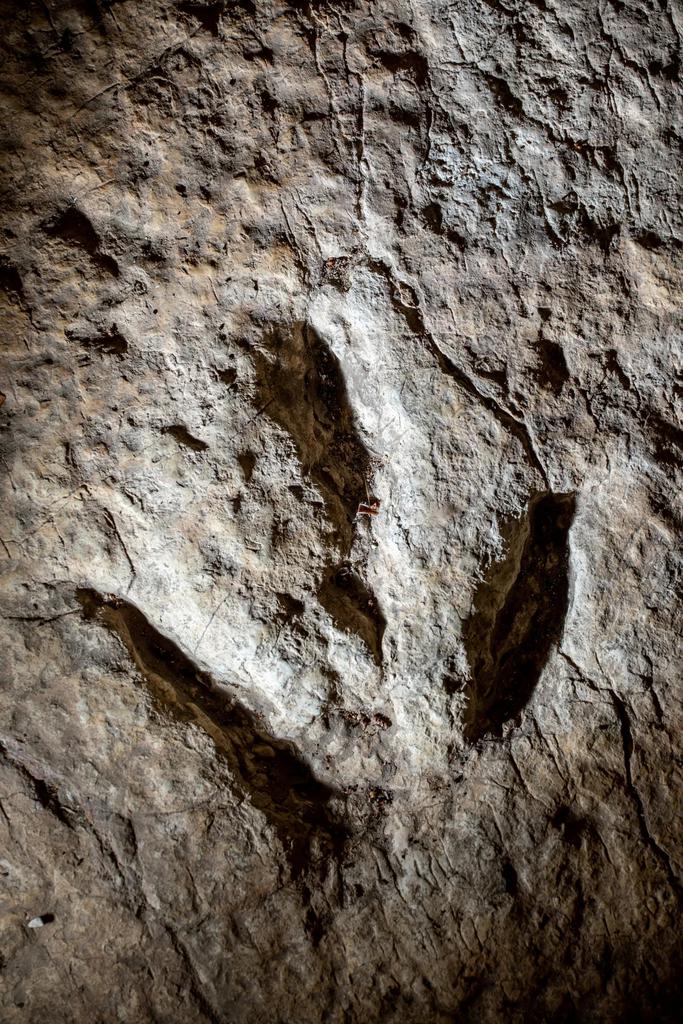
A dinosaur footprint at Beit Zayit. The picture comes from this article: https://www.haaretz.com/israel-news/2021-08-18/ty-article-magazine/a-very-brief-history-of-dinosaurs-in-the-holy-land/0000017f-e796-dea7-adff-f7ff27340000
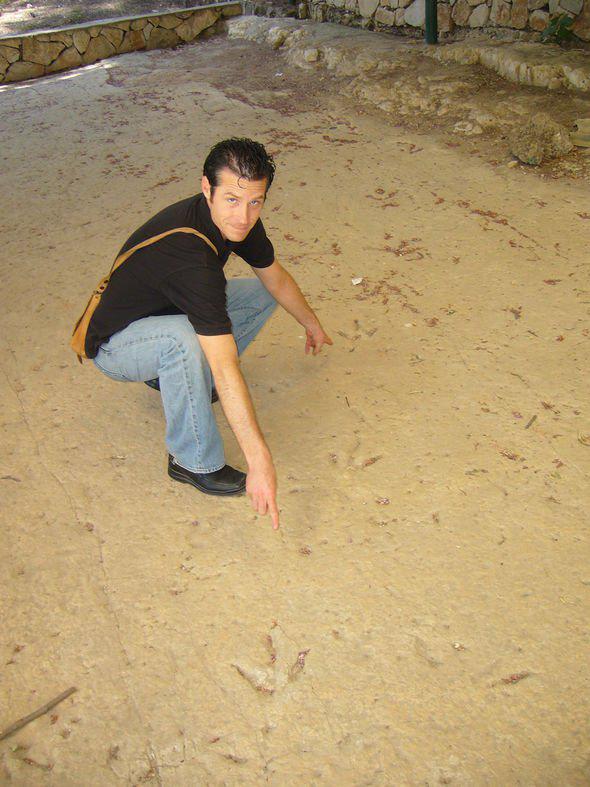
This is what the tracks overall look like. The image comes from this article: https://www.express.co.uk/news/weird/1381725/dinosaurs-beit-zayit-israel-dinosaur-tracks-palaeontology-news-evg
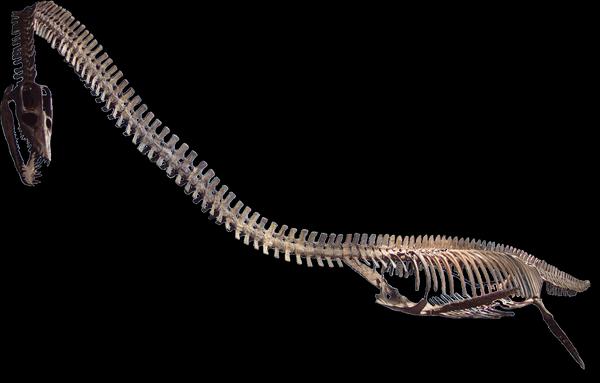
This is an elasmosaurus like the one found in Israel. You can read more here: https://www.haaretz.com/life/2015-02-11/ty-article/.premium/archaeologist-finds-8m-giant-lizard-fossil-in-israel/0000017f-db3b-df9c-a17f-ff3bdc350000?lts=1704475023501 (you'll need to make a free account with HaAretz).
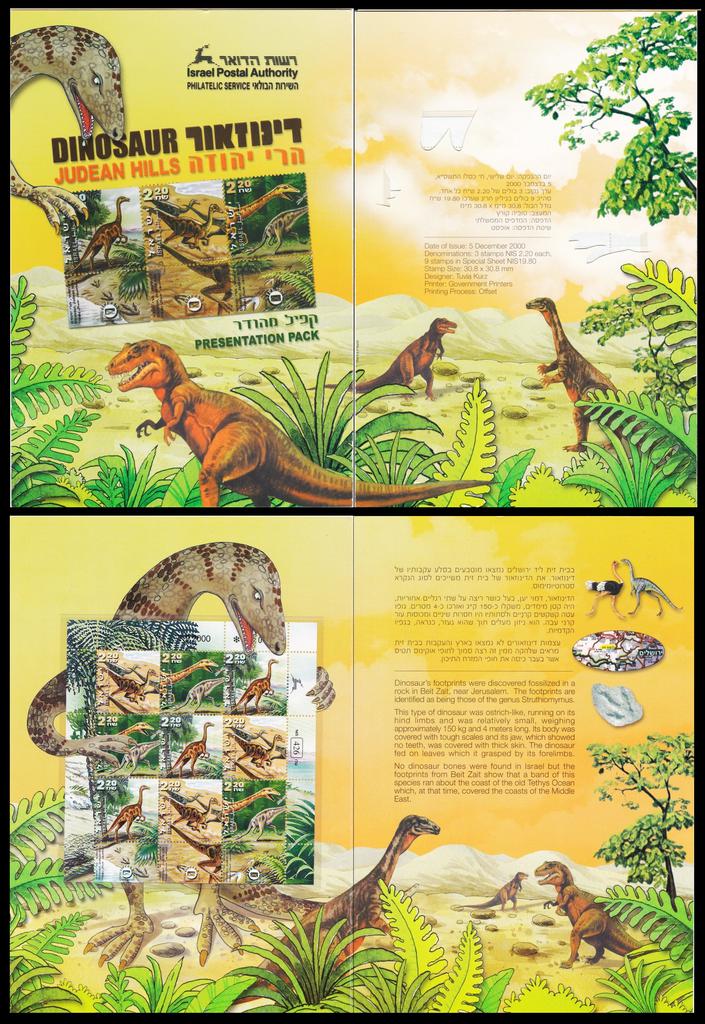
This is the booklet of stamps that were issued in Israel on May 12, 2000. To read more about the dinosaurs and the stamps, see here: https://www.paleophilatelie.eu/description/stamps/israel_2000.html
Jewish Paleontologists
Besides the ones in Israel, there have been a number of Jewish paleontologists over the years. Here are a few:
1. Steven Jay Gould (1941-2002) — did a lot of work on evolutionary biology including during the period of the dinosaurs. He is best known for “punctuated equilibrium”, the idea that evolution is usually very stable and then has moments of change, rather than constantly changing (https://en.wikipedia.org/wiki/Stephen_Jay_Gould)
2. Johanna “Tilly” Edinger (1897-1967) — founded the field of paleoneurology. She escaped Germany to London and then the United States and continued her work (https://en.wikipedia.org/wiki/Tilly_Edinger)
3. Roy Plotnick (?- present) — a professor emerita at the University of Illinois Chicago, and a specialist in paleobiomechanics. He also authored the article “Jurassic Pork: What Could a Jewish Time-Traveler Eat?” (For more about him, see https://eaes.uic.edu/news-stories/congratulations-to-our-newest-emeritus-professor-roy-plotnick/ And https://eaes.uic.edu/profiles/plotnick-roy/)
4. Jessica Theodor (?-present) — a professor at the University of Calgary. She examines fossils to see how organisms responded to changes in climate and how that might shed light on our current situation with climate change (https://contacts.ucalgary.ca/info/bio/profiles/124-2243)
5. Jon Favreau and Steven Spielberg — filmmakers of the documentary “Prehistoric Planet” and the “Jurassic Park” films
6. Ross Geller (1994-2004) - Arguably the most famous Jewish paleontologist, he was a character on the show “Friends” (https://en.wikipedia.org/wiki/Ross_Geller)
Clips of Ross Geller as a paleontologist
The intersection of Jews and paleontology, from MyJewishLearning
Israeli paleontologists weighing in on whether dinosaurs were cold-blooded or warm-blooded
Triceratops Shofars?
Could you make a shofar from the horn of a triceratops? No, because only kosher animals can be used (besides cows, which could remind G-d about the Golden Calf).
Animal Extinctions Then and Now
The dinosaurs went extinct, and humans had nothing to do with it. Animal species go extinct every so often. The problem is that since the time of humans, animal species have been going extinct much more rapidly than they were before humans. What do our Jewish texts have to say about this?
Generally, they don’t approve. We say in Ashrei (Psalm 145:9), “Tov Adoshem lakol, v’rachamav al kol ma’asav” — “G-d is good to all, and G-d’s mercy extends to all that G-d made.”
Adam was put into the Garden of Eden “l’ovda ulshomra”, “to work the earth and to guard it” (Genesis 2:15).
Rabbi Judah the Prince did not have mercy on a calf, and G-d afflicted him with suffering for years until he finally had mercy on some weasels (Bava Metzia 85a:6-7).
According to the Midrash, “Even animals that are considered superfluous like flies and gnats have a purpose to their creation” (Bereishit Rabba 10:7)
In the weekday Shacharit morning service we quote from Psalms 104:24 - “Ma rabu…” — “How great are your works, O Lord; You made all of them wisdom, the Earth is full of Your creations”.
For a range of Orthodox views on animals going extinct, see here: https://www.jewishpress.com/judaism/halacha-hashkafa/is-it-proper-should-a-frum-jew-care-if-an-animal-species-is-endangered-or-goes-extinct/2019/07/31/
Bible Stories via Dinosaurs
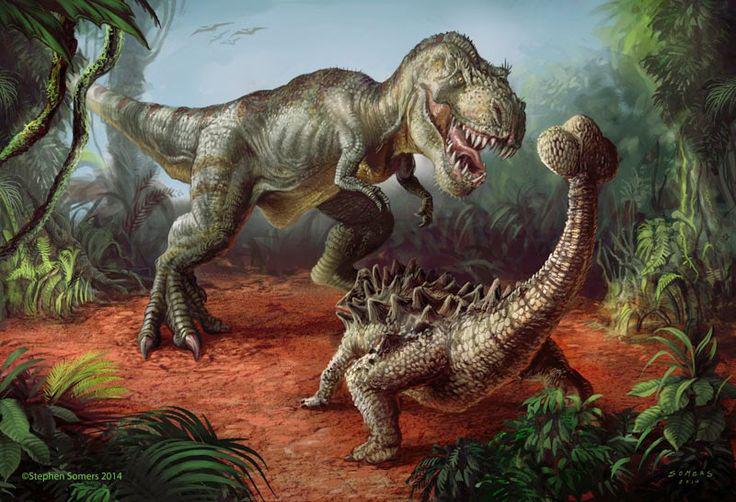
Bible stories can be accessed through many approaches. For instance, which Bible story would you say the anklyosaurus and tyrannosaurus rex are demonstrating?
Is there a Blessing for Dinosaurs?
One of the Big Ideas in Judaism is having an attitude of gratitude. A vehicle for this is saying blessings, expressing our appreciation for having an experience. There is a blessing for lots of things in Judaism — going to the bathroom (https://youtu.be/t5gWtDTD1y4), smelling a pleasant spice (https://youtu.be/Gebsb-po8jY), even for the czar (https://youtu.be/8jZFnKZcids).
So what would be the blessing for seeing a dinosaur? The topic never actually came up in all of the tractates of the Talmud. However, there is precedent in Jewish law that can inform this question. Usually, when seeing an individual plant (like a flower) or animal (like a cat) over which you want to say “Good job, G-d!”, the blessing is:
ברוך אתה ה, אלוהינו מלך העולם, שככה לו בעולמו
Baruch ata Adoshem, Elokeinu Melech haOlam, shekacha lo baOlamo.
Praised are You, Lord our G-d, Ruler of the universe, who has such things in G-d’s world.
However, there is another blessing for things in nature. This blessing is for really big things in nature — sunsets, the ocean, mountain ranges, etc. This blessing is:
ברוך אתה ה, אלוהינו מלך העולם, עושה מעשה בראשית
Baruch ata Adoshem, Elokeinu Melech haOlam, Oseh ma’aseh v’reishit.
Praised are You, Lord our G-d, Ruler of the universe, who makes the makings of Creation.
Maxine Handelman argues that dinosaurs are big enough to warrant this blessing, because this is an “awesome power of creation” blessing. Either way, there is an additional blessing that probably ought to be said upon seeing a dinosaur, especially if you live long enough to say a blessing at all:
ברוך אתה ה, אלוהינו מלך העולם, שהחיינו וקיומנו והגיענו לזמן הזה
Baruch ata Adoshem, Elokeinu Melech haOlam, Shehechiyanu v’kiyamanu v’higi’anu lazman hazeh.
Praised are You, Lord our G-d, Ruler of the universe, who has kept us alive, sustained us, and brought us to this moment.
Dinosaurs and Jewish Values
The first 3 are from Maxine Segal Handelman’s book What’s Jewish About Butterflies?
While dinosaurs are not Jewish, there are still Jewish values that can be associated with them.
1. Ma’aseh B’reishit (the miracle of creation) — As the blessing discussion shows, dinosaurs can be credited to G-d. Handelman writes, “Although dinosaurs are not listed among the things created in the Torah during the six days of creation, we can still look to God as the creator of these incredible beings." For what it’s worth, zebras are not listed in the Torah either, yet those who assign days of creation to animals would have no problem putting them on the sixth day.
2. Talmud Torah (the love of learning) — there is much to learn about dinosaurs, and they are fascinating to people of all ages. This ties into the Jewish value of love of learning, and possibly also “Torah Lishma”, learning for its own sake (unless one is studying to become a professional paleontologist).
3. Kavod (respect) — if one encountered a dinosaur, presumably one would treat it with respect.
4. Hachnasat Orchim (hospitality) — if a dinosaur knocked on your door and wanted to spend Shabbat with you (hypothetically), how would you show them hospitality?
5. Kehilla (community) — dinosaurs lived all over the world, and their individual groups each did things in a certain way, but there were certain things that all dinosaurs had in common, uniting them as a world-wide group of dinosaurs (kippah tip to Judy Van Der Stelt and Barry Shainker)
Dinosaur Hebrew
From Maxine Segal Handelman’s book What’s Jewish About Butterflies?
Dinosaur = דִינוֹזָאוּר = Di-no-za-or
Skeleton = שֶלֶד = She-led
Bone = עֶצֶם = E-tzem
Herbivore = אוֹכֵל עֵשֶֹב = O-chel ei-sev
Carnivore = אוֹכֵל בַָּשָׂר = O-chel ba-sar
Teeth = שִׁנַיִם = Shi-na-yim
Horn/s = קֶרֶן / קַרְנַיִם = Ke-ren / Kar-na-yim
Fossil = מְאֻבָּן = M’-u-ban
Egg = בֵּיצָה = Bei-tza
This is a very big dinosaur! = !זֶה דִינוֹזָאוּר מַמָשׁ גָדוֹל = Zeh di-no-za-or ma-mash ga-dol!
Dinosaurs lived a long time ago. = .דִינוֹזָאוּרִים קַיָמִים מִזְמַן = Di-no-za-u-rim ka-ya-mim miz-man.
Dinosaurs Meet Chanukah
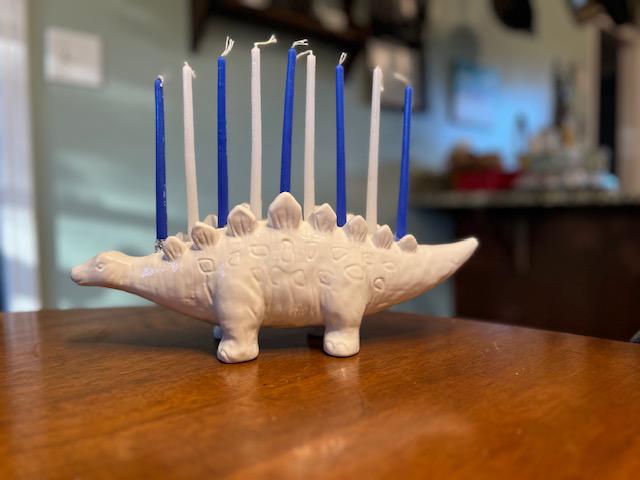
Context: This is a "menorasaurus". While ideally the candles would all be in a straight row, at least the shamash is higher than the rest. This particular specimen belongs to Liza Pratt and Ashley Ellis.
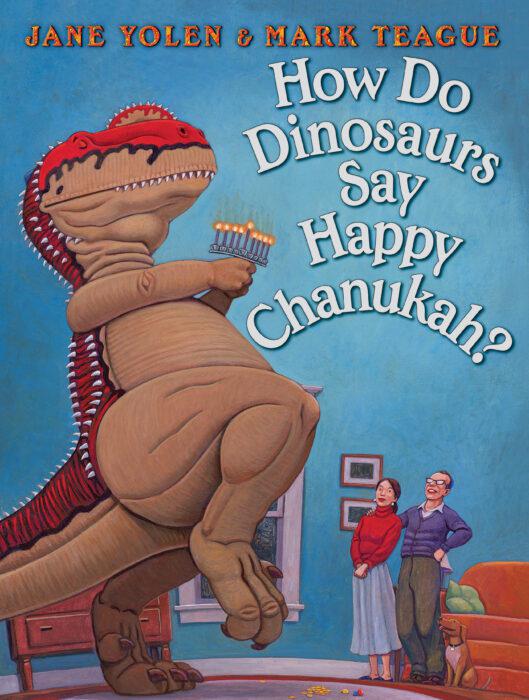
Jane Yolen is a Jewish-American author who has written 400 books (like The Devil's Arithmatic), including 24 "How do Dinosaurs..." books. This is the only Jewish one in the series (matching the Christmas one).
This is Passover, not Chanukah. Tyrannosaurus Tsuris is written by Susan Tarcov in 2024. Note that "tsuris" and "matzah" are pronounced with a "ts", like "nuts", and "seder" is pronounced "say-der", not like "cedar".
How Do Dinosaurs Celebrate Shabbat?
By Maxine Segal Handelman, inspired by the stories of Jane Yolen
Published in: What's Jewish About Butterflies?, by Maxine Segal Handelman, A.R.E. Publishing, Denver, 2004.
Used with permission of the author.
How does a dinosaur celebrate Shabbat when he comes to your home on Friday night?
Does a dinosaur blow out the candles on his way in the door?
Does he spill the wine all over the floor?
Does a dinosaur toss the challah with glee, and eat all the challah before saying "motzi"
Does a dinosaur grimace and fight?
How does a dinosaur celebrate Shabbat when she sees you in synagogue on Saturday morn?
Does a dinosaur run up the aisles and stand on the chairs?
Does she leap from the bima and dance on the stairs?
Does a dinosaur drop the siddur on the ground, and giggle with friends as the Torah goes round?
Does a dinosaur cry and complain?
No, dinosaurs don't. They make Shabbat a delight.
They munch on their challah and sip at their wine.
They say, "Shabbat Shalom". They sing Shabbat songs.
They shake hands with the rabbi. They eat special Shabbat treats.
Shabbat Shalom.
Shabbat Shalom, little dinosaur.
With appreciation to: Maxine Handelman, Wikipedia, Liza Pratt, Katie Schwartz, and Cantor Neil Schwartz.
Appendix A: The Original Dinosaur Song
“There’s a Dinosaur Knocking at My Door” (1989)
By: Linda Arnold
There’s a dinosaur knocking at my doorKnocking one, two, threeThere’s a dinosaur knocking at my doorAnd he wants to play with me“Knock, knock”“Who’s there?”“Tyrone”“Tyrone who?”“Tyronasaurus RexAnd I’m here to play with you”There’s a dinosaur knocking at my doorKnocking one, two, threeThere’s a dinosaur knocking at my doorAnd he wants to play with meThough mother went out to town for the dayShe never said that dinosaursWeren’t allow to playSo, I opened up the doorAnd I said, “Come in.”He wagged his tailAnd he gave me a grinThen he squeezed and he squeezed‘Til he came right throughWith the door, the windowAnd the front wall tooThere’s a dinosaur knocking at my doorKnocking one, two, threeThere’s a dinosaur knocking at my doorAnd he wants to play with meWell, he rubbed his tummyAnd he said “Let’s eat!”I went into the kitchen to fix him up a treatI opened up a jar of crunchy peanut butterHe ate the jar and allAnd said “I think I’ll have another!”I turned around and foundThe whole refrigerator goneHe looked at me and burpedAnd said, “Did I do something wrong?”There’s a dinosaur knocking at my doorKnocking one, two, threeThere’s a dinosaur knocking at my doorAnd he wants to play with me Well, we started taking turnsJumping on my parents’ bedHe only had half a turnThen the bed was deadOn the second jumpHis head went through the roofHe blinked his eyes and said,“Oops! I think I made a goof!”Suddenly I saw my motherComing through the doorSo, I said “Guess what? I’ve got a dinosaur!”“Hi!”There’s a dinosaur knocking at my doorKnocking one, two, threeThere’s a dinosaur knocking at my doorAnd he wants to play with me“Let’s order some pizza!”
credits
from Happiness Cake, released January 1, 1989Publishers: Linda Diane Arnold
https://lindaarnold.bandcamp.com/track/theres-a-dinosaur-knocking
Appendix B: Another Dinosaur Chanukah Book
Appendix C: “Jewish Dinosaurs”
By: Mark Miller
If you Google “Jewish history”, you’ll get approximately 345,000,000 results covering virtually every conceivable aspect of the topic – except one. Perhaps you’ve already guessed. That’s right – Jewish dinosaurs. Stunned that there was virtually nothing on the topic, I decided to be proactive. The result, after three years of scholarship, research and intense writing, is my upcoming fully-illustrated book, The Complete History of Jewish Dinosaurs. Here, for those impatient to wait for publication, is a brief excerpt.
What I found was at once strange and wonderful, making perfect sense once the facts were illuminated, and it was simply this: that many of the features, qualities, beliefs and principles the founders of Judaism used to create the religion were based on their own study and admiration of the characteristics of what have come to be known as Jewish dinosaurs. Here is a representative sampling of the creatures who prided themselves on never eating Jurassic pork.
Schleposaurus
The Schleposaurus, due to its imposing size (130 feet long and weighing 6.4 tons) specialized in hauling huge boulders, trees, and entire human families from one location to another, for a fee. Yes, it was the Uber of dinosaurs. Fees ranged from food to animal pelts to I.O.U.s for work. And yet all this vital work had its downside – the Schleposaurus, after decades of transporting heavy weight, developed numerous muscular and skeletal afflictions which could only be treated by making an appointment to see the following Jewish dinosaur.
Chiroraptor
The Chiroraptor was the doctor of the dinosaur community. Other dinosaurs with musculoskeletal injuries would frequently seek out the Chiroraptor, who would walk on the injured dinosaur’s back until it was realigned. Dinosaur parents encouraged their children to become Chiroraptors, as the profession was held in high regard, despite the fact that legitimate dinosaur doctors never considered the Chiroraptors to be actual doctors.
Gigantonagus
Think it’s hard to get kids to behave, keep their rooms clean, eat properly, and not tease their siblings? Imagine that times one hundred and you’ll have some idea of the challenges faced by dinosaur parents in dealing with their progeny. Hence, the development over eons of the Gigantonagus, the world’s largest nagging reptile. These resourceful and yet highly annoying creatures were faced on a daily basis with getting their young ones to not eat one another, destroy their caves, trample smaller creatures, share the smaller creatures they trampled, and treat their parents with respect rather than answering them back, in dinosaur language, with the equivalent of, “You’re not the boss of me!”
Comedatops
As distinguished from its close relative, the Triceratops, the Comedatops was the joker or comedian of the dinosaur world. It would have fit right in to the Jewish comics of the Catskills much later. Nothing gave it more pleasure than playing practical jokes on its dinosaur friends. For example, it would dig a huge hole in the ground, cover it with several layers of ferns, and ask a friend if he or she could identify a strange insect it had placed in the middle of the ferns. The friend would, of course, fall for it, literally, and fall through the hole, whereupon the Comedatops would laugh and laugh, and then kill and devour its friend. Now that’s comedy! The Comedatops would even do a primitive form of stand-up. One of its jokes: “What does a Triceratops sit on? It’s Tricerabottom.”
Nudgeasaurus
Ever found yourself aware that you needed to do something, but just couldn’t summon the desire, motivation, or energy to do so? Perhaps all you needed was a little prod, poke, dig, jab, push, or nudge. Enter the legendary Nudgeasaurus, which innately sensed your need and would provide that motivational poke. Know you need to hunt food for your family, but would prefer staycationing in the cave watching the fire? Perhaps a timely jab from the Nudgeasaurus’s 27-foot spikey tail might bring you swiftly to your feet and on your way. Also known as the most annoying dinosaur, the Nudgeasaurus understandably received the fewest party invitations. (Which, of course, didn’t stop them from attending anyway.)
Bubbiesaurus Rex
The queen of the dinosaur grandmas, the Bubbiesaurus Rex excelled at dinosaur childcare. If she wasn’t cooking, cleaning, or lecturing her own children about how to properly raise their children, she was sitting around the cave fire, enlightening her family about her life “back in the day”. Bubbie, as her loved one called her, never stopped worrying about her family’s health, safety, and happiness. She never asked for anything for herself, claiming she was only truly fulfilled when she was able to do all she could for her family. But lest you think she was some soft-hearted pushover, she was fully capable of biting the heads off any dinosaur intruder foolhardy enough to attempt to attack her loved ones. She even wrote a song about it: “To All the Heads I’ve Chomped Before”.
Pterodactowitz
The legendary Pterodactowitz was not a dinosaur per se, but rather a flying Judaic reptile. Early species had long fully toothed jaws and long tails. Many sported furry coats and were known as the largest flying creatures of all time. In terms of its Jewish nature, Pterodactowitz fossils reveal creatures that davened, created and ran businesses, acknowledged the value of the female, and had a self-deprecating sense of humor. There was even, briefly in 1963, a Broadway musical centered around the creature. Titled Pterodactowitz on the Roof, it lasted for just nine memorable performances before closing, yet its influence can be noted in subsequent, more successful Broadway musicals; especially Fiddler on the Roof.
https://aish.com/jewish-dinosaurs/
Appendix D: Mezuzahs and Dinosaurs
By: David Schwartz
Perhaps you’ve seen a mezuzah. You know, the box that we put on our doorposts containing Deuteronomy 6:4-9 (“The Shema and V’Ahavta”) and Deuteronomy 11:13-21 (“V’haya Im Shamo’a”). Like it says in Deuteronomy 6:9, “Write [these words] on the doorposts of your homes and on your gates.”
Why do we do this? Unfortunately, there’s no second half of the verse saying, “…so that when you touch it upon entering your house, you will remember that this is a Jewish space”, nor “… in order that when you leave you remember to be Jewish wherever you go.”
This brings us to dinosaurs. I was asked to teach a class about the intersection of Judaism and dinosaurs. At first I thought there was nothing to teach. After all, dinosaurs are not mentioned in the Torah, the Talmud, or even the Shulchan Aruch. “Dinosaur Day” is not a Jewish holiday (it is, however, real, and celebrated on May 15 and/or June 1 - https://www.twinkl.com/event/dinosaur-day-2024). In the world there are discussions about dinosaurs, and there are discussions about Judaism, and generally they are not overlapping.
After consulting with Maxine Segal Handelman, author of What’s Jewish About Butterflies?, though, I was found out that there are areas of overlap. There are dinosaur discoveries in Israel and Jewish values associated with dinosaurs. There are Jewish paleontologists (not just Ross Geller from “Friends”) and there’s Hebrew vocabulary. There are stories about dinosaurs celebrating Chanukah, and songs about dinosaurs visiting for Shabbat. One can even ponder the hypothetical kashrut of dinosaurs.
So what does this have to do with mezuzahs? The mezuzah has a dual function. On the one hand, it marks a home as a Jewish space. Particularly when the world seems unfriendly, it is important to have a safe space at home to be Jewish. At home, one can try to find ways to incorporate Judaism into seemingly non-Jewish topics, like dinosaurs (“menorasaurus”, anybody?). On the other hand, it is important to bring one’s Jewish identity into the outside world in ways that feel safe. Everybody has something to contribute from their personal background into the wider world, even that if that thing is a Jewish angle on dinosaurs (like dinosaurs having been found in Israel). Two verses before it talks about mezuzahs, the Torah says that we should speak of [Judaism] when we are at home and way, and it seems reasonable to connect that to the mezuzah, viewing it as a reminder. May we always feel safe and brave enough to bring our world into Judaism and Judaism into our world!
Appendix E: Michael Stein was Another Jew Who Thought Dinosaurs Rock
Michael Stein was the Hebrew School music teacher at Adas Israel in DC around 1990. He produced an entire album called “Dino Rock”, all of which you can find on YouTube.




